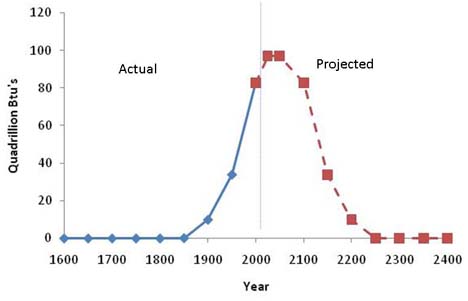Ten fundamentals about bioenergy: Part 3 fossil fuels
Editor’s note: This article is from the archives of the MSU Crop Advisory Team Alerts. Check the label of any pesticide referenced to ensure your use is included.
Fundamental #3: The earth’s supply of fossil fuel is finite.
This is the third in a series of brief articles regarding ten fundamental components of bioenergy. The topic for this article regards the finite supply of fossil fuel available to us humans here on earth. The objective is not to strike fear into our hearts, but rather to highlight the importance of addressing energy policy in the context of this important fact.
Unlike our generation, future generations will not have the luxury of fossil fuels that are readily available, and easily converted to liquid transportation fuels. This fact was already recognized by Henry Ford when he experimented with biofuels such as biodiesel and ethanol. A cursory review of history (see Figure 1) shows that our not too distant great grandparents got along fine in the absence of fossil fuels by using bioenergy. Similarly, future generations will get along fine without fossil fuels by using alternative sources of energy including bioenergy – although a completely modernized version of bioenergy.
America’s reliance on fossil fuel energy did not really begin until quite recently in our history. In the year 1885, coal first passed wood as the U.S. primary energy source thus beginning the “fossil fuel era.” Today, 83 percent of our 99.2 quadrillion U.S. Btu energy consumption comes from fossil fuels. Our contemporary generation will be unique in the fact that we will comprise the small blip in the human history timeline that relied on fossil fuel energy rather than renewable energy.
In the first article, we discussed how petroleum is made from the process of photosynthesis performed by plants and oceanic micro-organisms that lived 300 million years ago. Similarly, coal, large natural gas deposits, and other fossil fuels are derived from processes requiring a geologic time scale measured in millions of years. It takes a long, long, time for Mother Nature to make oil and coal. However, modern man uses fossil fuels in a very sped-up time frame. This process of continually relying on our fossil fuel supply can be compared to my bank account – I haven’t been able to make deposits lately, so eventually it is going to zero out if I keep making withdrawals. The USEPA estimates that today’s proven oil reserves will likely supply the world at current consumption trends until roughly about the decade 2040. Perhaps even more concerning, the United States controls only 2 percent of the world proven reserve oil supply. Development of new exploration and extraction technology will likely lead to the discovery and accessibility of new oil reserves in the future which will push the “out of gas” date a little further ahead in time.
However, it is clear that a sustainable future will require divergence from the current reliance on fossil fuel energy. My father cultivated the soil behind horses in his youth and travelled on jet airliners as an adult. That is a dramatic example of transition from bioenergy to petroleum energy in a single generation. It is certainly not outside the realm of possibility for our generation to make a similar leap in technology and begin the transition from fossil fuel energy to modern renewable, alternative sources of energy.
Figure 1. Actual (USDoE statistics) and a projected future scenario for U.S. fossil fuel use.

Projections are based on a linear increase until 2025 based on current usage (y = 0.73x - 1381.2) and a symmetrical decline until 2250. The projected use curve assumes future discovery of fossil fuel deposits and a gradual transition to alternative sources of energy.
Read part 1, part 2, part 4, part 5, part 6, part 7, part 8, part 9, part 10 of this series.



 Print
Print Email
Email


